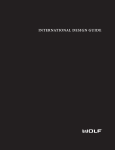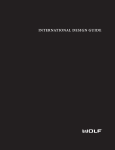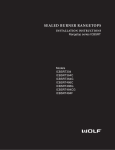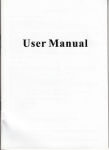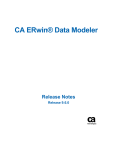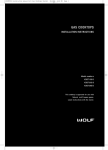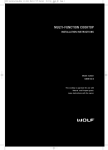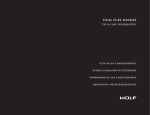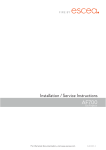Download Wolf DUAL FUEL RANGES Specifications
Transcript
DUAL FUEL RANGES INSTALLATION INSTRUCTIONS Model Ser ies C M Y CM MY CY CMY K ICBDF304 ICBDF366 ICBDF364C ICBDF364G ICBDF486C ICBDF486G ICBDF484CG ICBDF484F ICBDF606CG ICBDF604CF This cooktop is approved for use with Natural gas . Leave instructions with the owner. W O L F DUAL FUEL RANGES I N S TA L L AT I O N R E Q U I R E M E N T S IMPORTANT NOTE: This installation must be completed by a qualified installer, service agency or gas supplier. R AT I N G P L AT E I N F O R M AT I O N Model Number Serial Number C O N TA C T I N F O R M AT I O N Imported and distributed by: Multyflex Website: www.multyflex.com.au IMPORTANT NOTE: Statutory requirements: This appliance shall be installed in accordance with the manufacturer’s installation instructions, local gas fitting regulations, municipal building codes, electrical wiring regulations, and AS/NZ5601 the Australian Standard for gas installations. Refer also to AS/NZ5601 for gas pipe sizing tables. Unsuitability for use in marine craft, caravans or mobile homes, unless each burner is fitted with a flame safeguard. As you read this use & care information, take particular note of the CAUTION and WARNING symbols when they appear. This information is important for safe and efficient use of the Wolf equipment. signals a situation where minor injury or product damage may occur if you do not follow instructions. states a hazard that may cause serious injury or death if precautions are not followed. In addition, this use & care information may signal an IMPORTANT NOTE which highlights information that is especially important. WOLF ® is a registered trademark of Wolf Appliance, Inc. IMPORTANT NOTE: Save these installation instructions for the local inspector’s use. Installation to be carried out only by an authorised person. If the information in this book is not followed exactly, a fire or explosion may result, causing property damage, personal injury or death. Do not modify this appliance. Please read the entire installation instructions prior to installation. Installer: please retain these instructions for local inspector’s reference, then leave them with the homeowner. Homeowner: please read and keep these instructions for future reference and be sure to read the entire use & care information prior to use. IMPORTANT NOTE: This appliance must be installed in accordance with local codes. The correct voltage, frequency and amperage must be supplied to the appliance from a dedicated, grounded circuit which is protected by a properly sized circuit breaker or time delay fuse. The proper voltage, frequency, and amperage ratings are listed on the product rating plate. Record the model and serial numbers before installing the dual fuel range. Both numbers are listed on the rating plate, located rear of removable lower panel. IMPORTANT NOTE: Installation and service must be performed by a qualified installer, service agency or the gas supplier. Do not store or use gasoline or other flammable vapors and liquids in the vicinity of this or any other appliance. A ventilation hood is recommended for use with the Wolf dual fuel range. WHAT TO DO IF YOU SMELL GAS: Do not try to light any appliance. Do not touch any electrical switch. Do not use any phone in your building. Immediately call your gas supplier from a neighbor’s phone. Follow the gas supplier’s instructions. If you cannot reach your gas supplier, call the fire department. I N S TA L L AT I O N I N S T R U C T I O N S BEFORE Y O U S TA R T Proper installation is your responsibility. Installations must be performed by a qualified or licensed contractor, plumber or gas fitter, qualified or licensed by the state, province or region where this appliance is being installed. You must also ensure that electrical installation is adequate and conforms with all local codes and ordinances. Proper gas supply must be available; refer to gas supply requirements on page 9. Electrical ground is required; see electrical requirements on page 10. Check the location where the range will be installed. The location should be away from strong draft areas, such as windows, doors and strong heating vents or fans. Do not obstruct the flow of air. The area in which you are installing this appliance must have an adequate supply of fresh air to ensure proper combustion and ventilation. Make sure you have everything necessary for proper installation. It is the responsibility of the installer to comply with the installation clearances specified on the product rating plate. The rating plate is located rear of removable lower panel. All openings in the wall or floor where the range is to be installed must be sealed. The cooking range to be installed only on the floor. When installing the range under existing cabinets where the installation does not meet the minimum cabinet clearances, install a ventilation hood or other noncombustible surface above the range to avoid burn hazards. Refer to minimum clearances on page 3. V E N T I L AT I O N O P T I O N S I N S TA L L AT I O N S P E C I F I C A T I O N S IMPORTANT NOTE: A suitable ventilation hood must be installed. We recommend a Wolf Pro Ventilation Hood be installed with the Wolf dual Fuel Range. Contact your Wolf dealer for details. MINIMUM CLEARANCES IMPORTANT NOTE: When installing a ventilation hood, refer to the specific requirements of the hood for the minimum dimension to countertop. I N S TA L L AT I O N S P E C I F I C A T I O N S Wolf dual fuel ranges come in 762 mm, 914 mm, 1219 mm and 1524 mm widths. Illustrations on pages 4–7 provide the overall dimensions and installation specifications for each width of dual fuel range. Each range is designed to fit between cabinets set at the distance specified by the unit. For example, a 914 mm range will fit a 914 mm opening. The exception is the 1524 mm unit which will require a 1530 mm opening. IMPORTANT NOTE: Cabinet opening dimensions shown in the installation specifications illustrations must be used. These dimensions provide for required clearances. Each unit is designed with a terminal block on the rear of the range. Have a qualified electrician or installer wire your unit from the electrical supply, through the knockout in the unit base and to the terminal block on the range. IMPORTANT NOTE: Locate the electrical supply within dimensions shown in the installation specifications illustrations and flush with back wall. IMPORTANT NOTE: Caution must be used in planning the proper installation of the Wolf dual fuel range to avoid fire or damage to adjacent cabinetry or kitchen equipment. Be sure to follow the minimum clearances established in the finished rough opening dimensions. For installation against a rear combustible surface a 254 mm classic stainless steel riser must be used. Refer part number 804387. Refer to the installation specifications illustration for your model on pages 4–7 for the exact rough opening dimensions. Maintain the following clearances to combustible materials: Minimum 457 mm clearance from bottom of upper cabinet to countertop, within 152 mm minimum side clearance. I S L A N D | P E N I N S U L A I N S TA L L A TIONS For island installations, the range should not be installed within an enclosure having an adjacent rear wall less than 305 mm from the rear of the unit that rises above the countertop. For peninsula installations, the range must have a 152 mm minimum clearance to the side wall, left or right side, and 305 mm minimum clearance to the rear wall. Refer to the installation specifications illustration for your model on pages 4–7 for the exact rough opening dimensions. Failure to locate the range without the proper clearances will result in a fire hazard. Minimum 762 mm clearance between countertop and bottom of wood or metal cabinet, which is protected by not less than 6 mm flame retardant millboard covered with not less than No. 28 MSG sheet steel, .4 mm stainless steel, or .6 mm aluminum or .5 mm copper. Minimum 914 mm clearance between countertop and bottom of an unprotected wood or metal cabinet. Bottom of ventilation hood must be 600 mm minimum to 914 mm maximum from countertop. Refer to the installation specifications illustration for your model on pages 4–7 for the exact rough opening dimensions and location of the gas supply and electrical. Wolf dual fuel ranges using natural gas will operate up to an altitude of 2438 m without any adjustment. Natural gas and LP gas installations from 2438 m to 3353 m need the high altitude conversion kit. 3 WOLF 749 mm DUAL FUEL RANGE OVERALL DEPTH 699 mm ICBDF304 1419 mm 235 mm Overall Width 759 mm Overall Height (to cooking surface) 937 mm Overall Depth 749 mm Opening Width 762 mm WITH 508 mm RISER 1165 mm WITH 254 mm RISER 613 mm 911 mm 937 mm OVERALL HEIGHT TO COOKING SURFACE* 635 mm 1038 mm 664 mm WITH 127 mm RISER 937 mm ISLAND TRIM 759 mm 1194 mm OVERALL WIDTH *937 mm MIN TO 991 mm MAX. IMPORTANT NOTE: In non-island applications, a minimum 127 mm riser is required for model ICBDF304. VENTILATION HOOD 600 mm min COUNTERTOP TO COMBUSTIBLE MATERIALS min TO COMBUSTIBLE MATERIALS (BOTH SIDES) 152 mm 600 mm min TO 914 mm max TO BOTTOM OF VENTILATION HOOD 330 mm 457 mm min max TO COUNTERTOP 762 mm FINISHED ROUGH OPENING WIDTH 914 mm 937 mm 216 mm 254 mm LOCATION OF GAS SUPPLY 330 mm LOCATION OF GAS AND ELECTRICAL EXTENDS 57 mm LOCATION OF ON FLOOR FROM BACK WALL ELECTRICAL 4 TO COOKING SURFACE 83 mm ISLAND INSTALLATIONS: 305 mm MINIMUM CLEARANCE FROM BACK OF RANGE TO COMBUSTIBLE REAR WALL ABOVE COUNTERTOP– 0 mm TO NON-COMBUSTIBLE MATERIALS Note A: Side clearances. If the distance measured from the periphery of the nearest burner to any vertical surface is less than 200 mm, the surface shall be protected in accordance with AS/NZ5601. Note B: The rangehood fitted above the cooktop must be installed according to the installation instructions for the rangehood. A minimum distance of 750 mm is required for a range hood and 750 mm for an exhaust fan. I N S TA L L AT I O N I N S T R U C T I O N S 749 mm 914 mm D U A L F U E L R A N G E S OVERALL DEPTH 699 mm MODEL ICBDF366 MODEL ICBDF364C 235 mm MODEL ICBDF364G 1445 mm WITH 254 mm RISER 616 mm 937 mm OVERALL HEIGHT TO COOKING SURFACE 911 mm 641 mm 1191 mm WITH 254 mm RISER 1064 mm WITH 127 mm RISER 911 mm OVERALL DIMENSIONS Overall Width 911 mm Overall Height (to cooking surface) 937 mm Overall Depth 749 mm Opening Width 914 mm Dimensions may vary to ± 3 mm. 1194 mm OVERALL WIDTH LEGS AND CASTERS ALLOW 54 mm HEIGHT ADJUSTMENT I N S TA L L AT I O N S P E C I F I C AT I O N S IMPORTANT NOTE: In non-island applications, a minimum 127 mm riser is required for model ICBDF366 and minimum 254 mm riser required for models ICBDF364C and ICBDF364G installed against a combustible surface. The island trim and 127 mm riser may only be used against a non-combustible surface for models ICBDF364C and ICBDF364G. VENTILATION HOOD 600 mm min COUNTERTOP TO COMBUSTIBLE MATERIALS 762 mm min FOR CHARBROILER NOTE A 330 mm 600 mm min TO 457 mm min 914 mm max TO BOTTOM OF VENTILATION HOOD max TO COUNTERTOP NOTE B 914 mm FINISHED ROUGH OPENING WIDTH 216 mm LOCATION OF GAS AND ELECTRICAL EXTENDS 76 mm ON FLOOR FROM BACK WALL 483 mm LOCATION OF ELECTRICAL 937 mm TO COOKING SURFACE 381 mm LOCATION OF GAS SUPPLY 914 mm 83 mm ISLAND INSTALLATIONS: 305 mm MINIMUM CLEARANCE FROM BACK OF RANGE TO COMBUSTIBLE REAR WALL ABOVE COUNTERTOP– 50 mm TO NON-COMBUSTIBLE MATERIALS Note A: Side clearances. If the distance measured from the periphery of the nearest burner to any vertical surface is less than 200 mm, the surface shall be protected in accordance with AS/NZ5601. Note B: The rangehood fitted above the cooktop must be installed according to the installation instructions for the rangehood. A minimum distance of 750 mm is required for a range hood and 750 mm for an exhaust fan. 5 W O L F DUAL FUEL RANGES 1219 mm D U A L F U E L R A N G E S ICBDF484 CG 749 mm OVERALL DEPTH ICBDF484 F 699 mm ICBDF486 C 235 mm ICBDF486 G 1445 mm WITH 254 mm RISER OVERALL DIMENSIONS Overall Width Overall Height (to cooking surface) Overall Depth Opening Width 616 mm 1216 mm 911 mm 937 mm OVERALL HEIGHT TO COOKING SURFACE 937 mm 749 mm 641 mm 1191 mm WITH 254 mm RISER 1064 mm WITH 127 mm RISER 1219 mm Dimensions may vary to ± 3 mm. 1194 mm 1216 mm OVERALL WIDTH LEGS AND CASTERS ALLOW 54 mm HEIGHT ADJUSTMENT I N S TA L L AT I O N S P E C I F I C AT I O N S IMPORTANT NOTE: In non-island applications, a minimum 254 mm riser is required for all 1219 mm models installed against a combustible surface. The island trim and 127 mm riser may only be used against a non-combustible surface. VENTILATION HOOD 600 mm min COUNTERTOP TO COMBUSTIBLE MATERIALS 330 mm 600 mm min TO 762 mm min 457 mm min 914 mm max FOR CHARBROILER TO BOTTOM OF VENTILATION HOOD NOTE A max TO COUNTERTOP NOTE B 1219 mm FINISHED ROUGH OPENING WIDTH 914 mm 254 mm 610 mm LOCATION OF GAS AND ELECTRICAL EXTENDS 76 mm ON FLOOR FROM BACK WALL 6 LOCATION OF GAS SUPPLY 330 mm LOCATION OF ELECTRICAL 937 mm TO COOKING SURFACE 83 mm ISLAND INSTALLATIONS: 305 mm MINIMUM CLEARANCE FROM BACK OF RANGE TO COMBUSTIBLE REAR WALL ABOVE COUNTERTOP– 50 mm TO NON-COMBUSTIBLE MATERIALS Note A: Side clearances. If the distance measured from the periphery of the nearest burner to any vertical surface is less than 200 mm, the surface shall be protected in accordance with AS/NZ5601. Note B: The rangehood fitted above the cooktop must be installed according to the installation instructions for the rangehood. A minimum distance of 750 mm is required for a range hood and 750 mm for an exhaust fan. I N S TA L L AT I O N I N S T R U C T I O N S 749 mm 1524 mm D U A L F U E L R A N G E S OVERALL DEPTH 699 mm ICBDF606CF I C B D F 6 04CF 235 mm 1445 mm WITH 254 mm RISER 616 mm 937 mm OVERALL HEIGHT TO COOKING SURFACE 911 mm 641 mm 1191 mm WITH 254 mm RISER 1064 mm WITH 127 mm RISER 1527 mm OVERALL DIMENSIONS Overall Width 1527 mm Overall Height (to cooking surface) 937 mm Overall Depth 749 mm Opening Width 1530 mm Dimensions may vary to ± 3 mm. 1194 mm OVERALL WIDTH LEGS AND CASTERS ALLOW 54 mm HEIGHT ADJUSTMENT I N S TA L L AT I O N S P E C I F I C AT I O N S IMPORTANT NOTE: In non-island applications, a minimum 254 mm riser is required for all 1524 mm models installed against a combustible surface. The island trim and 127 mm riser may only be used against a non-combustible surface. VENTILATION HOOD 600 mm min COUNTERTOP TO COMBUSTIBLE MATERIALS NOTE A 330 mm 600 mm min TO 762 mm min 457 mm min 914 mm max FOR CHARBROILER TO BOTTOM OF VENTILATION HOOD NOTE B max TO COUNTERTOP 1530 mm FINISHED ROUGH OPENING WIDTH 787 mm LOCATION OF GAS AND ELECTRICAL EXTENDS 76 mm ON FLOOR FROM BACK WALL 330 mm LOCATION OF ELECTRICAL 937 mm TO COOKING SURFACE 254 mm LOCATION OF GAS SUPPLY 914 mm 83 mm ISLAND INSTALLATIONS: 305 mm MINIMUM CLEARANCE FROM BACK OF RANGE TO COMBUSTIBLE REAR WALL ABOVE COUNTERTOP– 50 mm TO NON-COMBUSTIBLE MATERIALS Note A: Side clearances. If the distance measured from the periphery of the nearest burner to any vertical surface is less than 200 mm, the surface shall be protected in accordance with AS/NZ5601. Note B: The rangehood fitted above the cooktop must be installed according to the installation instructions for the rangehood. A minimum distance of 750 mm is required for a range hood and 750 mm for an exhaust fan. 7 W O L F DUAL FUEL RANGES U N PA C K T H E R A N G E Remove and discard all packing materials, including cardboard and tape on the outside of the range and inside the oven cavity. Remove the box containing the oven racks, oven rack guides and broiler pan from inside the oven cavity. Be sure to do this for both oven cavities on the 1524 mm range. Remove the burner grates and styrofoam off the top cooking surface. Be sure to remove the burner caps packaged in styrofoam below the burner grates. Do not discard the angle iron supplied with the range. This is the anti-tip bracket and must be installed with the unit. Refer to anti-tip bracket installation on page 11. Carefully lift the range off the pallet and remove the styrofoam from the bottom of the unit. The dual fuel range is very heavy. Use caution when lifting and moving the unit. Secure oven door(s) closed before moving the unit. OVEN DOOR R E M O VA L Do not lift the range by the oven door handle(s). This will damage the oven door and hinges. IMPORTANT NOTE: Before moving the range into position, protect any finished flooring with appropriate materials to avoid damage to the floor. The rear of the range has rolling casters which allows for easy movement of the range by picking up on the front of the unit. Refer to the illustration below. Failure to insert the hinge pin in the appropriate hinge arm will cause damage to the range. Minor injuries may occur. IMPORTANT NOTE: The oven door(s) should not be removed unless it is necessary to fit the range through a tight doorway. Door removal should only be done by a qualified service technician or installer. Door removal and reinstallation may cause damage to the oven porcelain interior. The dual fuel range comes from the factory at an overall height of 911 mm from floor to the top of the bullnose, before any height adjustment. The legs and casters allow for 54 mm height adjustment. Refer to the illustration below. Use a 19 mm socket to adjust the rear casters. Refer to the installation specifications illustration for your model on pages 4–7 for additional dimensions. If removal of the oven door(s) is necessary, a hinge pin, supplied with the range, will need to be inserted in the appropriate hinge arm. For each oven door, only one hinge arm is spring loaded, requiring use of the hinge pin for removal of the oven door. The hinge pin will be found taped to the inside of the oven door. For 762 mm and 914 mm ranges, the hinge pin will be inserted through the hole in the right hinge arm (facing the unit). On 1219 mm and 1524 mm ranges, the spring hinges are located on the outer edges of the unit. On these units, the left oven door will have the spring hinge on the left side and the right oven door will have the spring hinge on the right side. Refer to the illustrations below for the location of the spring hinge(s) for your model. Casters allow for 54 mm height adjustment Place Hinge Pin on Spring Hinge Side of Door Rolling casters. 8 Spring hinge location for 762 mm and 914 mm ranges. Place Hinge Pins on Spring Hinge Side of Door Spring hinge locations for 1219 mm and 1524 mm ranges. I N S TA L L AT I O N I N S T R U C T I O N S OVEN DOOR R E M O VA L If removal of the oven door(s) is necessary, follow these steps: 1) Remove the lower kickplate assembly to access the lower hinge retainer mounting screws. 2) Open the oven door to its fully opened position and remove both upper and lower hinge retainer mounting screws. The oven gasket may have to be moved slightly to access the bottom screws. 3) After removing the mounting screws, move the hinge retainer plate forward slightly. The hinge retainer plate will remain on the door hinge assembly after the mounting screws have been removed. 4) Insert the supplied door hinge pin through the hole in the appropriate hinge arm. Refer to the illustration below. 5) Carefully close the oven door to about a 60° angle from horizontal and lift the door away from the oven. A slight rocking motion may be required for removal. 6) For 1219 mm and 1524 mm ranges, complete these steps for both oven doors Do not lift or carry the oven door by the door handle. Hinge Retainer Plate Upper Mounting Screw G A S S U P P LY R E Q U I R E M E N T S EXPLOSION HAZARD — Securely tighten all gas connections. G A S S U P P LY C O N N E C T I O N Never test for a gas leak with a match or other flame. Failure to do so can result in explosion, fire or death. IMPORTANT NOTE: The dual fuel range must be connected to a regulated gas supply. The rating plate, located rear of removable lower panel, has information on the type of gas that should be used. If this information does not agree with the type of gas available, check with the local gas supplier. A duplicate plate can be attached to the inside top of an adjacent cupboard. This appliance appliance must be installed in a position with the proper level of ventilation. Do not obstruct the flow of combustion and ventilation air. The gas pressure regulator supplied with the appliance must be installed in line with the gas pipe. (N.G. only). If the appliance cannot be adjusted to perform correctly contact Multyflex or the local gas utility. For service contact telephone number please refer page 13. For pressure testing in excess of 3.5 kPa (1/2” psig) the appliance and its individual shut-off valve must be disconnected from the gas supply piping system. For pressure testing of the gas piping system at pressures equal to or less than 3.5kPa (1/2”psig) the appliance must be isolated from the gas supply system by closing its individual shut off valve during any pressure testing. Gas connection: The cooktop is adjusted to operate on the gas type specified on the gas type label located on the bottom of the unit. If in doubt as to the type of gas available contact the network operator or gas supplier for confirmation of gas type. The cooktop must be connected to the gas supply with upstream connection of an isolation valve in accordance with the respectively valid regulations. We recommend that the isolation valve be fitted prior to the cooktop to enable isolation of the cooktop from the gas supply. The valve must be easily accessible at all times. Fit regulator (N.G.) or Propane fitting (Propane) directly to the R1/2” connection. direction for gas flow is indicated on the rear of the regulator. Check correct operation of each burner individually and in combination. Burner flames should be clear blue, with no yellow tipping. If the burners show any abnormality check that burner heads are correctly located and refer to the ‘trouble shooting’ guide on page 26 & 27 of the Use and Care manual. If satisfactory performance can not be obtained, contact Multyflex or the local gas utility. For service contact number refer page 13 of this booklet. Note: These burner have no aeration adjustment. It should be expressly noted that we cannot accept any liability for direct or indirect damage caused by wrong connection or improper instalThis appliance may be connected with a hose lation. When being repaired, the appliance must assembly, class B or class D in accordance to always be AS/NZS 1869. If connected with a hose assembly ensure that the gas disconnected supply connection point is accessible from the main with the appliance installed. gas and electricity supply; if The position of the inlet connection is required,notify measured from bottom RH rear of unit, our customer 75 mm centre line from rear and 300 mm service. centre line from RH side. The appliance should not be connected to a combustion product evacuation system. Hinge Pin Instruct the user in the operation of the appliance before leaving.. Kickplate Oven door removal. 9 W O L F D U A L F U E L RA N G E S GAS R AT I N G E L EC TR I C A L R E QU IR E M E NT S G A S R AT IN G Verify that power is disconnected from the electrical box before proceeding. Refer to page 13 The complete appliance must be properly grounded at all times when electrical power is applied. REQUIRED POWER SUPPLY NOTE: Improper connection can result in a re hazard. Single phase: 220-240V AC; 50/60 Hz 3phase: 380-415V AC; 50/60 Hz Before obtaining access to terminals, all supply circuits must be disconnected. MAXIMUM CONNECTED LOAD 762 mm and 914 mm Dual Fuel ranges: Single phase: 19 amps 3phase: 18 amps 1219 mm Dual Fuel ranges: Single phase: 35 amps 3phase: 18 amps 1524 mm Dual Fuel ranges: Single phase: 38 amps 3phase: 18 amps Refer to the wiring diagram showing the connections for each lead to the terminal box on the unit. Single phase wiring diagram Open the terminal box to expose the screws with corresponding numbers. Run the cord through the strain relief hole and into the terminal box. For Single Phase Install (Line, Neutral, Ground): Loosen the 1, 5, and ground screws. Attach the Neutral wire to the number 5 position. Line should be attached to the 1 postion and attach the ground to the corresponding ground screw. For 3phase Install (L1, L2, L3, Neutral, Ground): Loosen the 1, 2, 3 and remove the copper bars. Loosen 5 and ground screws. Attach L1 to position 1. L2 to position 2. L3 to position 3. Neutral wire to position 5 and attach the ground to the corresponding ground screw. IMPORTANT NOTE: Connection of this appliance should be through a fused connection unit or a suitable isolator, which complies with national and switch should local safety regulations. The o be easily accessible after the appliance has been installed. If the switch is not accessible after installation (depending on country) an additional means of disconnection must be provided for all poles of the power supply. When switched there must be an all pole contact gap of 3 mm in the isolator switch. This 3 mm contact disconnect gap must apply to any isolator switch, fuses and/or relays according to EN60335. Copper bars must be removed from positions 1, 2, and 3 when connecting to 3phase power. 3phase wiring diagram I M PO R T A N T N O T E Be aware of local code s and ordinances when insta lling you r service. 10 I N S TA L L AT I O N I N S T R U C T I O N S ANTI-TIP BRACKET I N S T A L L A T I O N This range can tip. Injury to persons could result. Install the anti-tip bracket supplied with the range. Raise the unit to its desired height by adjusting the front legs and rear casters. The legs and casters allow for 54 mm height adjustment. Use a 19 mm socket to adjust the rear casters. The front legs are adjusted by rotating the bottom hexagonal portion of the leg. The anti-tip bracket can be installed by securing it to the wall or floor using the supplied hardware. Refer to the chart and illustration below to determine the proper distance from the left side of the opening to the anti-tip bracket. This will ensure the anti-tip bolt properly engages the bracket. MODEL DRYWALL APPLICATIONS ANTI-TIP BOLT ADJUSTMENT After properly positioning the anti-tip bracket, use wall anchors to fasten it to the wall. Using a Philips screwdriver or a low rpm screw gun, drive the anchor into the surface of the wallboard until the two cutting blades penetrate the surface. Use gentle forward pressure to rotate the collar until flush with the surface of the wall. Refer to the illustrations below. Use #8 screws and flat washers to fasten the anti-tip bracket to the wall. Once the bracket is secured in place, adjust the anti-tip bolt at the back of the range so the top of the washer is 22 mm maximum from the floor. Slide the range into the opening and verify the anti-tip bolt is engaged. Refer to the illustrations below. IMPORTANT NOTE: The top of the range must be level. Use the adjustable front legs and the rear casters to level the range. WOOD FLOOR APPLICATIONS A 5 mm 914 mm Range 14 mm 1219 mm Range 5 mm 1524 mm Range 8 mm IMPORTANT NOTE: The oven door(s) should not be removed unless it is necessary to fit the range through a tight doorway. Door removal should only be done by a qualified service technician or installer. Door removal and reinstallation may cause damage to the oven porcelain interior. CONCRETE FLOOR APPLICATIONS 2) Holding the oven door at an approximate 30° angle from vertical, slide the hinges into the openings until the bottom hinge arms drop fully into the hinge receptacles. 4) Reinstall the hinge retainer plate with upper and lower mounting screws. OVEN DOOR R E I N S T A L L A T I O N 762 mm Range 1) Hold the oven door on both sides and position it with door hinges aligned with openings in the oven frame. 3) Open the oven door to its fully opened position. Remove the hinge pin from the appropriate hinge arm. Refer to the illustration below. IMPORTANT NOTE: Pre-drill holes if difficulty is encountered during installation of the wall anchor. For hard wallboard or double-board construction, use a 6 mm drill bit. For solid plaster, use a 11 mm drill bit. After properly positioning the anti-tip bracket, drill 5 mm pilot holes through the floor. Use #12 screws and flat washers to secure the bracket to the floor. If oven door(s) have been removed, follow these steps to reinstall: 5) Open and close the door completely to ensure that it is properly installed. 6) For 1219 mm and 1524 mm ranges, complete these steps for both oven doors. 7) Reinstall the lower kickplate assembly. IMPORTANT NOTE: Fully extend the hinge claw which is opposite the hinge pin location and insert into the hinge pocket prior to inserting opposite side. This will ease the installation of the oven door. After properly positioning the anti-tip bracket drill 10 mm holes into the concrete a minimum of 38 mm deep. Use 10 mm wedge anchors to secure the bracket to the floor. Do not lift or carry the oven door by the door handle. Hinge Retainer Plate WALL ANCHOR ANTI-TIP BRACKET Upper Mounting Screw Hinge Pin A ANTI-TIP BRACKET ANTI-TIP BOLT ANTI-TIP DEVICE ENGAGED 22 mm MAX Kickplate Anti-tip bracket location. Wall anchor installation. Anti-tip bolt adjustment. Anti-tip bolt engaged. Oven door reinstallation. W O L F DUAL FUEL RANGES C O O K T O P O P E R AT I O N VERIFY R A N G E O P E R AT I O N REMOVING T H E R A N G E TROUBLES H O O T I N G The cooktop burner uses an electronic igniter in place of a standing pilot. When the cooktop control knob is pushed in and turned to the position, the system creates a spark to light the burner. This sparking continues for 4 seconds or until the electronic ignition senses a flame, which ever comes first. If the igniter fails to ignite the gas in 4 seconds, the gas safety shutoff valve will close, eliminating the gas flow for 5 seconds. The valve will reopen after the purge time of 5 seconds, and the igniter will automatically attempt to re-ignite the gas. This cycle of events is attempted 3 times. After the third attempt, in order for gas to flow to the burner once again, the user must return the knob to the position and then turn the knob to the position. IMPORTANT NOTE: Prior to operating the range, be sure to read the entire Wolf dual fuel ranges use & care information included with the range for important safety and service information. If removing the dual fuel range is necessary for cleaning or service, shut off the gas supply. Disconnect the gas supply and electrical connections to the unit, then remove the range. Reinstall in the reverse order and be sure to check the gas connection for leaks. IMPORTANT NOTE: If the dual fuel range does not operate properly, follow these troubleshooting steps: Install the oven rack guides onto the shoulder screws located on the interior side walls of the oven. Slide the oven racks onto the support racks within the oven. There are three racks per oven, except for the 457 mm oven which has two racks. Place the broiler pan and grid on a rack within the oven, if desired. Refer the Wolf dual fuel ranges use & care information included with the range for cleaning recommendations. To check operation of the cooktop burner, push in and turn the control knob to the position. The flame should light within four seconds. If the burner does not light properly, turn the control knob to the position. Check that the burner head is in the proper position. Check that the power supply cord is plugged in and that the circuit breaker or house fuse has not blown. Check operation again; If flame is not established within the ignition cycle time, release the knob, open a door and wait 1 minute before attempting a new ignition procedure. If the flames are extinguished - for any reason whatever - turn OFF the control knob and wait at least 1 minute before retrying to ignite the burner. Ensure that the flames do not extinguish when you reduce to low flame quickly. Check correct operation of each burner individually and in combination. FLAME HEIGHT AND APPEARANCE The flame on natural gas should be blue with a deeper blue core. and no yellow tipping. If burners show any abnormality check that burner heads are correctly located and refer to the ‘ trouble shooting guide’ on this page. If satifactory performance can not be obtained, contact Multyflex. For service contact number refer page 13 of this booklet. IMPORTANT NOTE: Initial lighting of the surface burners may take slightly longer, as air in the system must be purged before gas can be supplied to the burner. 12 Turn on the power supply to the range. The control panel should be closed (no visible control pads). Touch and slightly depress the flame graphic on the hidden control panel to open. Set the time of day by pressing the touch pad, scroll to the desired time by using the or arrows, then touch . After setting the time, the hidden control panel can be closed. The control panel does not have to be open to operate the oven. Select any of the eight cooking modes by using the oven control knob bezel and turning to the desired mode. Once the mode has been selected, the temperature can be adjusted by turning the temperature readout knob clockwise to increase the temperature or counterclockwise to decrease the temperature. Verify that the oven is coming up to temperature. For a 1219 mm or 1524 mm range, follow this procedure for the both ovens. IMPORTANT NOTE: A small amount of smoke and odor may be noticed during the initial break-in period. Refer to the use & care information for additional information. Verify that power is being supplied to the range. Check the gas supply and electrical connections to ensure that the installation has been completed correctly. Check that gas valves are turned to the ON position. Be sure to disconnect the gas supply and electrical connections before removing the range. Follow troubleshooting procedures as described in the Wolf dual fuel ranges use & care information. If the range still does not work, contact a Wolf dealer. Do not attempt to repair the range yourself. Wolf is not responsible for service required to correct a faulty installation. I N S TA L L AT I O N I N S T R U C T I O N S SERVICE I N F O R M A TI O N BEFORE CALLING FOR SERVICE Serial Number Before calling your Wolf dealer, refer to the troubleshooting guide on page 12. Check the household fuse or circuit breaker to see if it has been blown or tripped and that the electrical connection to the appliance has not been disconnected. A power outage may also have caused a disruption in service. Installation Date Wolf Dealer and Phone GSCS20230 SAI GLOBAL AS4551 Made in USA Model No: ICBDF304 Serial No: Gas type Test point press. (kPa) Injector sizes (mm) RHF RHR LHF LHR NG 1.0 LPG 2.75 1.80 1.80 1.80 1.35 1.09 1.09 1.09 0.89 Total Consumption (MJ/h) 51.0 51.1 GSCS20230 SAI GLOBAL AS4551 Made in USA Model No: ICBDF366 Serial No: NG 1.0 LPG 2.75 1.80 1.80 1.09 1.09 LHF LHR Total Consumption (MJ/h) 1.80 1.35 79.0 1.09 0.89 79.1 Gas type Test point press. (kPa) Injector sizes (mm) RHF RHR Grill LHF LHR Total Consumption (MJ/h) GSCS20230 SAI GLOBAL AS4551 Made in USA NG 1.0 LPG 2.75 1.80 1.80 1.78 1.80 1.35 66.0 1.09 1.09 1.09 1.09 0.89 66.1 Gas type Test point press. (kPa) Injector sizes (mm) RHF RHR Griddle LHF LHR Total Consumption (MJ/h) Made in USA Model No: ICBDF484CG Serial No: Model No: ICBDF364G Serial No: Model No: ICBDF364C Serial No: Gas type Test point press. (kPa) Injector sizes (mm) RHF/CF RHR/CR MF018 GSCS20230 SAI GLOBAL AS4551 Made in USA The wiring diagram covering the control circuit is located rear of the removable lower panel. 1300 808 859 MF028 MF022 MF027 For service call: GSCS20230 SAI GLOBAL AS4551 WIRING D I A G R A M Model Number MF016 When requesting information, literature, replacement parts or service, always refer to the model and serial number of your dual fuel range. This information is found on the product rating plate located rear of the removable lower panel. Refer to the illustration below. Record the rating plate information below for future reference. NG 1.0 LPG 2.75 1.80 1.80 1.70 1.80 1.35 66.0 1.09 1.09 1.09 1.09 0.89 66.1 Gas type Test point press. (kPa) Injector sizes (mm) RHF RHR Grill Griddle LHF LHR NG 1.0 LPG 2.75 1.80 1.80 1.78 1.70 1.80 1.35 1.09 1.09 1.09 1.09 1.09 0.89 Total Consumption (MJ/h) 81.0 81.1 Electrical compliance: in accordance with AS/NZS3100 240 V AC, 4.5 kW/19 Amps, 50 Hz Electrical compliance: in accordance with AS/NZS3100 240 V AC, 4.5 kW/19 Amps, 50 Hz Electrical compliance: in accordance with AS/NZS3100 240 V AC, 4.5 kW/19 amps, 50 Hz Electrical compliance: in accordance with AS/NZS3100 240 V AC, 8.4 kW/35 Amps, 50 Hz Imported & distributed by Suite 1, 151 Barkley Avenue. Burnley VIC 3121 t: +61 3 9421 0232 Imported & distributed by Suite 1, 151 Barkley Avenue. Burnley VIC 3121 t: +61 3 9421 0232 Imported & distributed by Suite 1, 151 Barkley Avenue. Burnley VIC 3121 t: +61 3 9421 0232 Imported & distributed by Suite 1, 151 Barkley Avenue. Burnley VIC 3121 t: +61 3 9421 0232 Imported & distributed by Suite 1, 151 Barkley Avenue. Burnley VIC 3121 t: +61 3 9421 0232 Made in USA Gas type Test point press. (kPa) Injector sizes (mm) RHF RHR French top LHF LHR Total Consumption (MJ/h) GSCS20230 SAI GLOBAL AS4551 Made in USA NG 1.0 LPG 2.75 1.80 1.80 1.80 1.80 1.35 65.0 1.09 1.09 1.09 1.09 0.89 65.1 Gas type Test point press. (kPa) Injector sizes (mm) RHF RHR Grill LHF/CF/CR LHR Total Consumption (MJ/h) GSCS20230 SAI GLOBAL AS4551 Made in USA NG 1.0 LPG 2.75 1.80 1.80 1.78 1.80 1.35 94.0 1.09 1.09 1.09 1.09 0.89 94.1 Gas type Test point press. (kPa) Injector sizes (mm) RHF/CF RHR/CR Griddle LHF LHR Total Consumption (MJ/h) MF026 GSCS20230 SAI GLOBAL AS4551 Made in USA NG 1.0 1.80 1.80 1.70 1.80 1.35 94.0 LPG 2.75 1.09 1.09 1.09 1.09 0.89 94.1 GSCS20230 SAI GLOBAL AS4551 Made in USA Model No: ICBDF606CG Serial No: Model No: ICBDF604CF Serial No: Model No: ICBDF486G Serial No: Model No: ICBDF486C Serial No: Model No: ICBDF484F Serial No: MF030 MF029 MF017 GSCS20230 SAI GLOBAL AS4551 MF023 Electrical compliance: in accordance with AS/NZS3100 240 V AC, 4.5 kW/19 Amps, 50 Hz NG 1.0 Gas type Test point press. (kPa) Injector sizes (mm) RHF RHR Grill French top LHF LHR LPG 2.75 1.80 1.80 1.78 1.80 1.80 1.35 1.09 1.09 1.09 1.09 1.09 0.89 Total Consumption (MJ/h) 80.0 81.1 Gas type Test point press. (kPa) Injector sizes (mm) RHF/CF RHR/CR Grill Griddle LHF LHR NG 1.0 LPG 2.75 1.80 1.80 1.78 1.70 1.80 1.35 1.09 1.09 1.09 1.09 1.09 0.89 Total Consumption (MJ/h) 109.0 109.1 Electrical compliance: in accordance with AS/NZS3100 240 V AC, 8.4 kW/35 Amps, 50 Hz Electrical compliance: in accordance with AS/NZS3100 240 V AC, 8.4kW/35 Amps, 50 Hz Electrical compliance: in accordance with AS/NZS3100 240 V AC, 8.4kW/35 Amps, 50 Hz Electrical compliance: in accordance with AS/NZS3100 240 V AC, 9.1 kW/38 Amps, 50 Hz Electrical compliance: in accordance with AS/NZS3100 240 V AC, 9.1 kW/38 amps, 50 Hz Imported & distributed by Suite 1, 151 Barkley Avenue. Burnley VIC 3121 t: +61 3 9421 0232 Imported & distributed by Suite 1, 151 Barkley Avenue. Burnley VIC 3121 t: +61 3 9421 0232 Imported & distributed by Suite 1, 151 Barkley Avenue. Burnley VIC 3121 t: +61 3 9421 0232 Imported & distributed by Suite 1, 151 Barkley Avenue. Burnley VIC 3121 t: +61 3 9421 0232 Imported & distributed by Suite 1, 151 Barkley Avenue. Burnley VIC 3121 t: +61 3 9421 0232 IMPORTED & D I ST R I B U T E D B Y : MultyFlex C O N TA C T I N F O R M AT I O N Website: www.multyflex.com. au The information and images in this book are the copyright property of Wolf Appliance, Inc., an affiliate of Sub-Zero, Inc. Neither this book nor any information or images contained herein may be copied or used in whole or in part without the express wri tten permission of Wolf Appliance, Inc., an affiliate of Sub-Zero, Inc. ©Wolf Appliance, Inc. all rights reserved. 13 Wiring diagram 14 Wiring diagram 15 Wiring diagram 16 Wiring diagram 17 Imported & distributed by Multyflex www.multyflex.com.au MF038




















